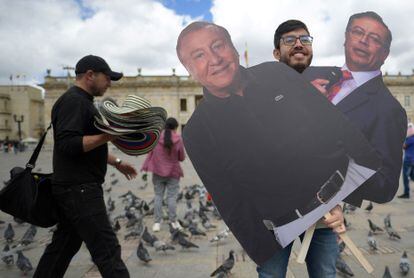A man poses holding cardboard posters with images of the candidates for the Presidency in Colombia in Bogotá.RAUL ARBOLEDA (AFP)
Finding, measuring and characterizing undecided voters is the most difficult task for any polling house, but it also becomes crucial when an election is as tight as the second round of the Colombian presidential election.
A little over a week from the date, all the polls point to a technical tie, making the final decision of those who still doubt decisive.
In Colombia, this figure could range from 7% to 14% of the total likely voters depending on the survey we take as a reference.
In any case, more than enough to tip the balance towards Rodolfo Hernández or Gustavo Petro.
That range is, in itself, very large: it could represent from less than a million to almost three million people.
But the first difficulty is precisely sizing them.
All polls in Colombia filter from the first part of their questionnaire to likely voters from unlikely ones.
The objective is to survey only those who have a high probability of ending up voting.
The interesting profile here is, within that group, those who do not yet have a candidate.
These non-aligned potential voters can explicitly declare their indecision, not answer the question, say they are going to vote blank, or that they do not intend to vote for any.
The evidence accumulated by political science indicates that the doubt of all of them is not produced so much between whether to go for one or another candidate,
but rather between exercising the vote for one or for none (blank, null, abstention).
This is even more true in polarized environments, such as Colombia.
So that filter exercise of each pollster becomes an analytical bet: who are the voters who will end up staying at home?
And which candidate will be more or less successful in persuading their potential voters to go to the polls?
For now, what we can look at is which candidate has the most persuadable voters among the nonaligned.
This is a sign of growth potential, but also of failure so far.
One way to make this approximation is to see how many undecideds there are among first-round voters based on what they chose then.
Naturally, the two candidates who moved up to second place have fewer doubters in their ranks, although Rodolfo Hernández went through an unusually high bout of indecision last week.
are the
exes
of Fico Gutiérrez and Sergio Fajardo who are, naturally, more undecided.
The interesting thing is that the trend for both is up, not down.
The normal thing would be for people to have a clearer vote as the days go by and information about those who remained in the fight increases, but what would be happening is just the opposite, specifically in the areas of the center (Fajardo) and the traditional right (Fico).
If we transform these trends into an estimate of how undecided voters are distributed according to what they voted in the first round, applying those percentages to the votes cast on May 29, we are left with 6 out of 10 voting for Gutiérrez.
And 1 out of 4, by Fajardo.
Since there has already presumably been a flight of centrist voters from 2018 to Petro in 2022, and since Fico could not be further ideologically removed from Petro, it can be assumed that the answer these data suggest to the question of who has more undecided in play is Rodolfo Hernández.
If we approach this same group from a sociodemographic perspective, the image that emerges is complementary.
For example, the area of the country where there is the highest percentage of undecided, according to the latest survey by the National Consulting Center (CNC), is the Coffee Region.
Just in that region, Federico Gutiérrez and Sergio Fajardo obtained high votes.
On the contrary, in the Center East of the country, where Rodolfo Hernández had the majority of his voters in the first round, people are much more sure of his decision.
Bogotá and the Caribbean, Gustavo Petro's strongholds, are less indecisive than the Coffee Region, but a little more than the Central East.
In the distribution by sex shown by the CNC, it is clear that women are, for now, much more undecided than men with 17% compared to 11%.
This may respond to recent sexist statements by candidate Rodolfo Hernández, in which he has said that women should be away from the government and that the ideal would be for them to dedicate themselves to raising children.
Regarding the distribution of the undecided by strata, the trend is similar to that of many elections in the world: the highest and lowest strata have much higher rates of indecision than the middle class.
Finally, the age of the people who still do not know who to vote for reveals a not so common electoral phenomenon, which reinforces the initial hypothesis that it is the candidate Rodolfo Hernández who has the most to gain and to lose among the hundreds of thousands of voters who do not vote. aligned that remain in Colombia.
Contrary to what usually happens just before an election, this time those over 55 are the most undecided, while young people seem more sure of their votes.
Hernández would be, therefore, the one who has the most to win, but also the one who can lose the most in this final stretch for the undecided.
The technical tie will be undone thanks to them, and the work of the candidates is clear in light of these data: not only persuading their own to go to the polls, but, perhaps, also convincing outsiders not to do so. .
Subscribe here
to the EL PAÍS newsletter on Colombia and receive all the key information on the country's current affairs.

